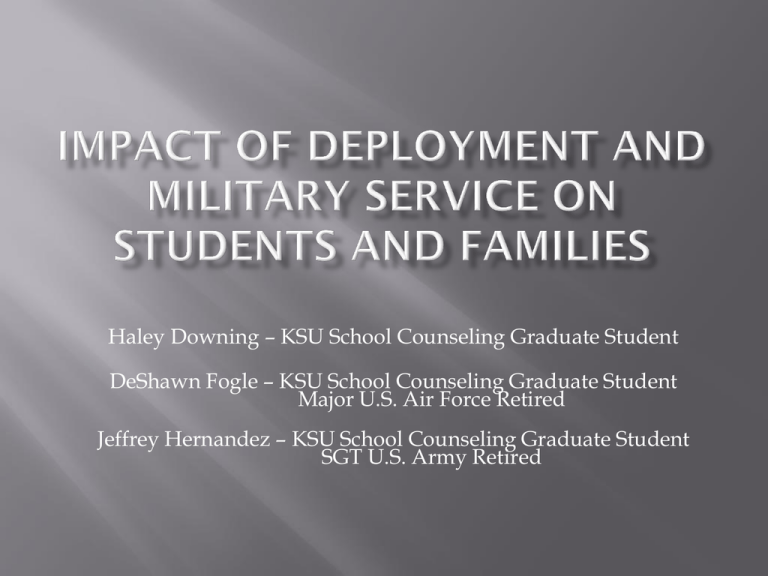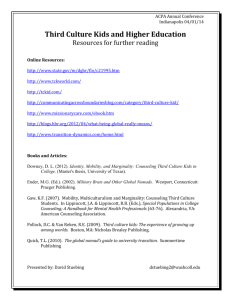File
advertisement

Haley Downing – KSU School Counseling Graduate Student DeShawn Fogle – KSU School Counseling Graduate Student Major U.S. Air Force Retired Jeffrey Hernandez – KSU School Counseling Graduate Student SGT U.S. Army Retired 24,699 Total Active Duty Military (Army, Navy, Air Force, Marine Corps, Coast Guard) 7,553 Civilians Working at Military Installations (Teachers, Customer Service Reps, etc) 361 Department of Defense Civilians – Employes of Dept of Defense Approx. 7,500 National Guard Men and Women 233,000 Veterans in the State of Kansas Thumbs up or down: Do we have a good understanding of the needs of our military-connected students and families? What are some of these needs? What did you hear that stood out to you as being important or surprised you from the video clip? Personal experience E.V.: 12 years service, noncustodial parent to two children, was a military child himself Strengths: Socially intelligent, compassionate and empathic Struggles: Sometimes chose inappropriate ways to try and fit in “When National Guard, Army Reserve and other military parents living in civilian communities are mobilized, their children have unique needs for special support and services. Now they are "military kids" but they still look the same to teachers, friends and the rest of the community. Their lives are turned upside down! Many of their usual support systems may no longer be adequate.” – Operation Military Kids Identity confusion- Am I now a military child? What does that really mean/what does that change? Not being located near or not knowing other military kids Reserve families are generally not located close to a military installation- don’t have access to the same services that other military families have i.e. healthcare, childcare Fosters maturity Growth inducing Encourages independence Encourages flexibility Builds skills for adjusting to separations and losses faced later in life Strengthens family bonds A student may show signs of serious stress during and immediately after deployment to war. The following signs indicate that the student is in acute distress and will need to be referred for immediate evaluation: Unfocused agitation or hysteria Disconnection from peers and adults Serious depression or withdrawal Auditory or visual hallucinations Any prolonged major change from normal functioning that continues six weeks after deployment After six to eight weeks: Have not been able to resume normal classroom assignments and activities Continue to have high levels of emotional response such as continued crying and intense sadness Continue to appear depressed, withdrawn and noncommunicative Continue to have difficulty concentrating in school Express violent or depressed feelings in “dark” drawings or writings Intentionally hurt or cut themselves or are at risk for hurting others Gain or lose a significant amount of weight in a period of weeks Discontinue taking care of their personal appearance Exhibit a possible drug or alcohol abuse problem How has your school or district sensitively met the needs of military connected students? What are some ideas you have or things you would like to try? Elementary Aged Students Engage in play activities Paint or draw pictures reflecting feelings and thoughts about how to make things better Write in a journal Read and discuss stories about children in conflict and children as problem solvers Write cards or letters to the deployed family member Make a memory book or calendar reflecting positive thoughts and actions Take part in individual and group counseling when problems arise Middle School and High School Aged Students Keep a journal Engage in art activities Write poetry Write stories Write cards or letters to the deployed family member Relax by doing deep breathing and muscles relaxation exercises Learn problem-solving strategies Participate in small group discussions Participate in support groups Exercise Listen to music Take part in individual and group counseling when problems arise Focus on student and the classroom learning environment Provide structure Maintain objectivity Reinforce safety and security Be patient and reduce student work load as needed Listen Be sensitive to language and cultural needs Acknowledge and validate feelings Reinforce anger management Teachers show their pleasure and enjoyment of students. Teachers interact in a responsive and respectful manner. Teachers offer students help (e.g., answering questions in timely manner, offering support that matches the children's needs) in achieving academic and social objectives. Teachers help students reflect on their thinking and learning skills. Teachers know and demonstrate knowledge about individual students' backgrounds, interests, emotional strengths and academic levels. Teachers seldom show irritability or aggravation toward students. Purpose: To sensitively respond to unique needs of military-connected children and families Phone privileges during school hours Skype access during school day Offering computer/internet access to community members Brainstorm: other potential accommodations or amendments to school policy? Has the family supplied the school with Family Care Plan info? Deployments can affect children’s sense of trust “Normal” kids will have difficulty dealing with a deployment- what additional issues can we anticipate for military children with special needs? Dads at a Distance Moms Over Miles Free tutoring http://military.tutor.com/ 4-H Military Partnerships Interactive iBook by Sandy Risberg Military-Connected Students in the Classroom Military Child Initiative- John Hopkins University Library of Best Practices (2013). Military active-duty personnel, civilians by state. Retrieved from http://www.governing.com/govdata/military-civilian-active-duty-employee-workforce-numbers-by-state.html American psychological association. (2015). Improving students’ relationships with teachers to provide essential supports for learning: Positive relationships can also help a student develop socially. Retrieved from http://www.apa.org/education/k12/relationships.aspx Battistich, V., Schaps, E., & Wilson, N. (2004). Effects of an elementary school intervention on students’ “connectedness” to school and social adjustment during middle school. Journal of Primary Prevention, 24(3). Birch, S.H., & Ladd, G.W. (1997). The teacher-child relationship and children’s early school adjustment. Journal of School Psychology, 35(1). Custer, K. (2014). A study of perceptions of mothers, caregivers, and school-age children regarding educational experiences during maternal army reserve component deployments. (Unpublished doctoral dissertation). Kansas State University, Manhattan, KS. Department of veterans affairs. (2009). Kansas and the U.S. department of veterans affairs. Retrieved from http://www.va.gov/opa/publications/factsheets/ss_kanas.pdf Educational opportunities directorate of the department of defense. (2011). Educator’s guide to the military child during deployment. Retrieved from https://www2.ed.gov/about/offices/list/os/homefront/homefront.pdf Hamre, B.K., & Pianta, R.C. (2001). Early teacher-child relationships and the trajectory of children’s school outcomes through eighth grade. Child Development, 72(2). Kansas adjutant general’s department. (2015). Kansas national guard. Retrieved from http://www.kansastag.gov/ng_default.asp National military family association. (2015). Info + resources. Retrieved from http://support.militaryfamily.org Operation: military kids. (2015). Operation: military kids (OMK). Retrieved from http://www.operationmilitarykids.org/public/statePOCHome.aspx?state=Kansas


